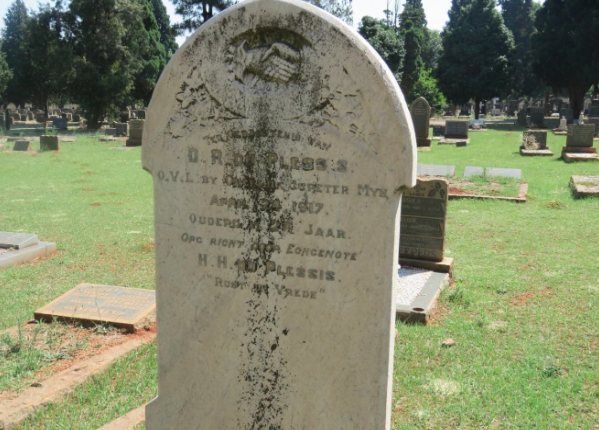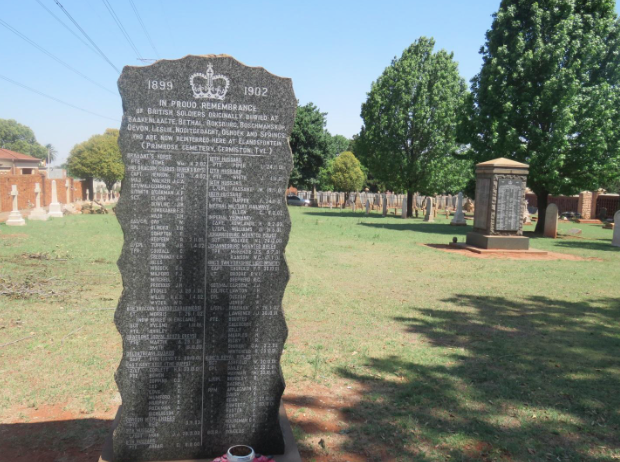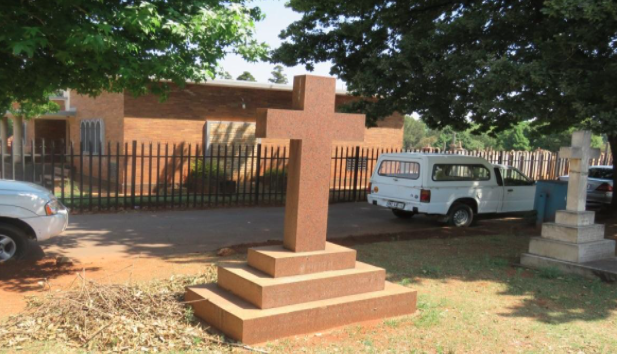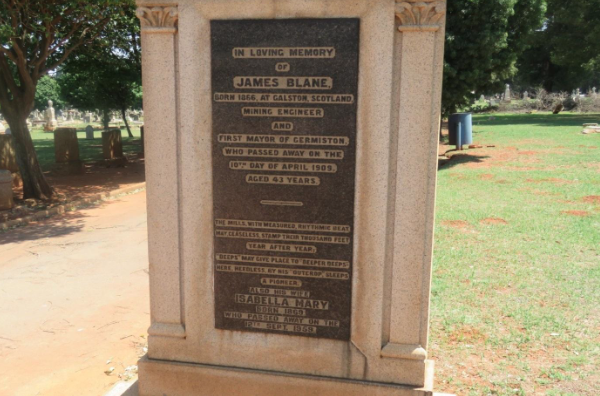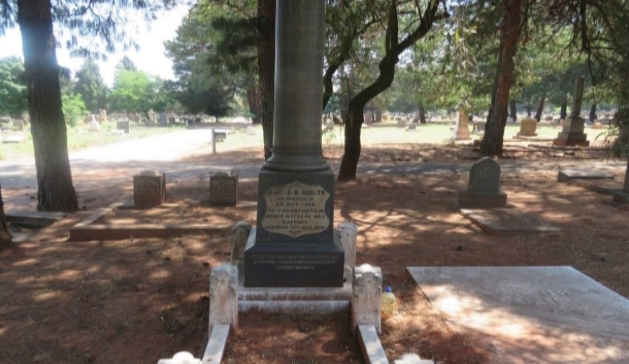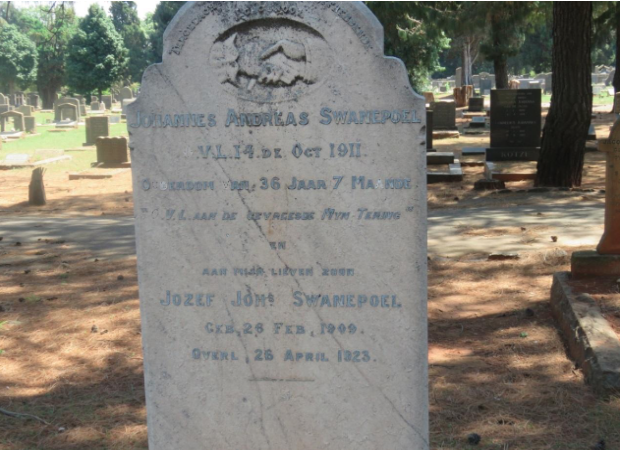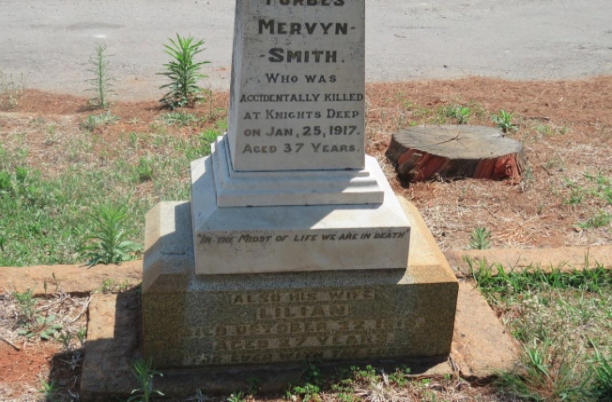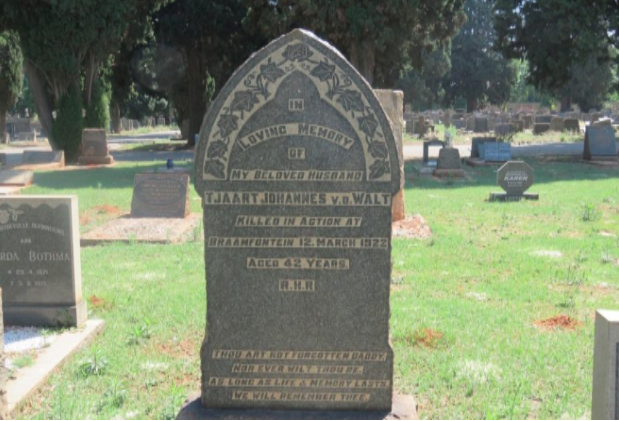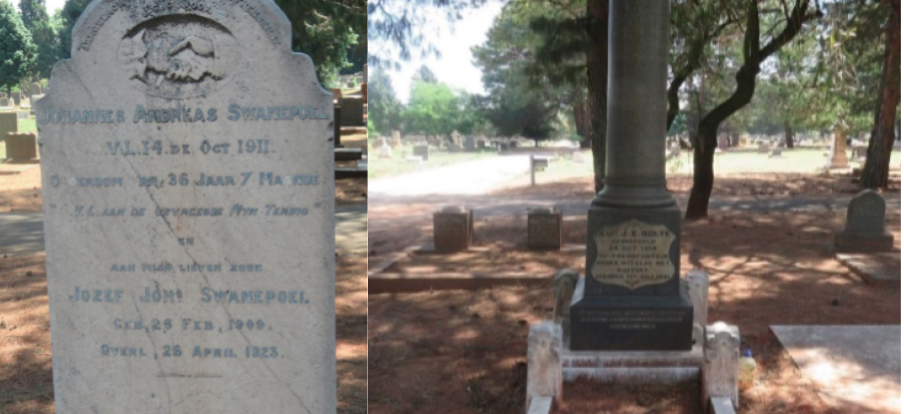
Disclaimer: Any views expressed by individuals and organisations are their own and do not in any way represent the views of The Heritage Portal. If you find any mistakes or historical inaccuracies, please contact the editor.
A friend who grew up in Germiston claimed at his recent birthday bash that while you could leave Germiston, it would never leave you. His words mulled through my mind as I arrived at the Primrose Cemetery. Visiting a historic cemetery like Primrose is similar to visiting an interesting museum. Instead of viewing artifacts one sees the tombstones of people who participated in events that may have shaped one’s life in one way or another. One also starts better interpreting the tombstone symbols and appraising the epitaphs.
A typical Victorian and Edwardian tombstone symbol - hand of deceased trustingly placed in God’s protective hand (SJ de Klerk)
The most touching epitaph I have read was on the obelisk commemorating Lady Sale who died in 1853. She was the wife of Sir Robert Sale who conquered Afghanistan in 1839. Lady Sale died only three days after landing in Cape Town, while travelling from India and was buried in the old Somerset Road Cemetery. Her obelisk was made in Calcutta, to the order of her children who composed the epitaph which begins, ‘Under this stone reposes all that could die of Lady Sale …’
The Primrose Cemetery is not quite as old and historical as the old Somerset Road Cemetery in Cape Town, which was closed in 1886 and regretfully built over in the 1920s, but it offers a glimpse of the last major battle of the Anglo Boer War in the Eastern Transvaal (now Mpumalanga), the early gold mining industry and occupational diseases associated with it, an infamous incident from the 1914 Afrikaner Rebellion, the 1918 Spanish Influenza Pandemic and the 1922 Rand Revolt.
This Cemetery, on the corner of Cydonia and the appropriately named Cemetery Road in Primrose, dates back to 1893. This makes it after the Braamfontein Cemetery the oldest in the Greater Johannesburg region. Approximately 20 000 burials have taken place here.
The first internment was of R. Lambert on 25 June 1893. Regretfully the writer could not find this grave.
The various sections of the Cemetery are poorly signposted, hence the location of the Military Garden of Remembrance next to the entrance in Cemetery Road will be used to orientate directions to interesting and historical graves.
Once one has entered from Cemetery Road and passed through the Cemetery gate the Military Garden of Remembrance is on the right (north). This Garden of Remembrance is about a quarter of an acre in extent and contains the remains of 544 Imperial soldiers from the Anglo Boer War, of which 181 died in battle or from their wounds. The remains of soldiers who died at Bakenlaagte, Bethal, Boschmanskop, Devon, Leslie, Nooitgedacht, Oshoek, Elandsfontein and Springs were also later reinterred here, when it became impossible to preserve their original burial sites. Only the Church Street Cemetery in Pretoria has a larger repository in Gauteng, of remains of Imperial Soldiers who died in the Boer War.
There are about fifty tombstones and contemporary monuments placed around the perimeter of this Garden of Remembrance. Amongst others, there is a monument to the Queen’s Bays Regiment in memory of their comrades who fell in action on 1 April 1902. This skirmish took place when 312 men of the Queen's Bays and 40 National Scouts who were stationed at Springs intended to raid at night what they thought was a small Boer laager, but instead stumbled on to a much larger Boer laager consisting of about 800 men under Generals Alberts and Piet Viljoen, near Boschman’s Kop (vicinity of present day Devon), who energetically counter attacked and inflicted many casualties on the attackers.
The wording on some of the monuments indicates they were originally erected at the various battlefield sites.
There are also two more recent monuments erected by the National Monuments Council listing all the names and regiments of the Imperial soldiers whose remains were interred here.
Memorials erected by the National Monuments Council commemorating names and regiments of Imperial soldiers interred at Primrose Cemetery (SJ de Klerk)
Colonel George Benson is the most senior military officer interred here. He was killed together with 77 of his men at the Battle of Bakenlaagte on 30 October 1901, which was the last major battle in the Eastern Transvaal.
To counteract the Boer guerilla war strategy, the British evolved a tactic of deploying fast-moving flying columns less dependent on large quantities of rations, forage and ammunition.
Colonel Benson commanded No. 3 flying column, which was based at Middelburg in the Eastern Transvaal and patrolled the area between Roossenekal, Lydenburg, Machadodorp, Ermelo, Carolina and Bethel. So successful was this column in moving long distances at night and launching dawn attacks on Boer Commandos, that it was known as "The Scourge of the Transvaal".
Benson was tasked to burn farms and collect Boer prisoners, taking them to Brugspruit station (now Cluwer) for transportation to concentration camps. To this end, on 20 October 1901, Benson's column left Middelburg heading south to Bethel, burning farms and collecting Boer men, women and children.
On 24 October 800 burghers ambushed the rearguard of the column and 14 of Benson's men were killed or wounded. Benson then changed his tactics from dawn raids to daylight clearing operations. On 30 October various Boer commandos under the overall command of General Louis Botha gathered to attack Benson’s force.
Benson's column advanced from Bethel, to near Bakenlaagte, in the mist and pouring rain with the commandos at their heels. In the afternoon the commandos headed for the British rearguard with their fast moving horsemen. Benson ordered an about-turn with fixed bayonets and the two remaining guns of the 84th battery commenced firing from the high ground where Benson took up position. The Boers then charged the guns. All the British officers in the immediate vicinity were killed and Benson mortally wounded. The Boers captured the guns and turned them on the convoy, but ceased fire when they realised that Boer women and children were with the column. Seventy seven of Benson’s men were killed with another 161 wounded. Fifty two Boers were killed and wounded.
The Battle of Bakenlaagte took place on the western side of the R547, about halfway between Kinross and Kriel.
Benson’s tombstone is an imposing cross of light brown granite. Unfortunately the bronze lettering on his tombstone has been removed by scrap metal collectors.
Tombstone of Lieutenant Colonel George Benson (SJ de Klerk)
There is an interesting tombstone to Captain Eyre Lloyd, 2nd Coldstream Guards also killed at Baakenlaagte. The epitaph states he was Assistant Staff Officer in camp and left a safe but relatively unimportant duty in camp and lost his life in a voluntary attempt to reach his wounded chief at the post of danger, persevering though wounded on the way.
There are also two monuments commemorating men from Germiston who died while serving in the First World War. One, a large and imposing obelisk, commemorates the employees from the Knights Deep Gold Mine, ‘Who laid down their lives in the Great War for Liberty’.
Immediately north of the Military Garden of Remembrance is the Anglican precinct, which is the oldest in this Cemetery. The monumental tombstone of the first Mayor of Germiston, James Blane, a mining engineer who died on 10 April 1909 at age 43, is situated immediately north of the cemetery roadway, separating the Military Garden of Remembrance from the Anglican precinct and is near a boundary gate, now permanently closed. It has an appropriate epitaph for the 1st Mayor of an important gold mining town, “The Mills with measured rhythmic beat, may ceaselessly stamp their thousand feet, year after year, ‘Deeps’ may give place to ‘Deeper Deeps’, here heedless by his ‘Outcrop’ sleeps, a Pioneer.”
Monumental tombstone to James Blane first Mayor of Germiston (SJ de Klerk)
A short distance towards the west on the northern side of the same roadway is the tombstone of General G. H. Gravett of the Boksburg Commando, which has a marble angel on top. General Gravett died at Witpoort in the Mapochsgronden (Roossenekal and Tonteldoos) in the Eastern Transvaal. The Boer forces were fighting a rear guard action and he suffered serious shrapnel wounds while standing next to one of the last artillery pieces of the ZAR State Artillery. He died at Roossenekal on 26 October 1900 and his remains were later reinterred here. The tombstone also commemorates his son R. E. Gravett born 15 May 1893 and died 20 October 1903. There is a tombstone of another G. H. Gravett at the Rynsoord Cemetery, who was born in 1892 and who died in an accident at the Brakpan Mine in 1920. One wonders whether this is another son of General Gravett.
There is one important tombstone which relates to the 1914 Afrikaner Rebellion, caused by South Africa’s decision to invade German South West Africa (Namibia) upon the outbreak of the First World War. This tombstone is that of Captain J. E. Nolte who was infamously shot and killed at Treurfontein (now Coligny) in the North West Province, in October 1914. It is located next to this roadway but slightly further towards the west. Captain Nolte was serving with government forces fighting the rebels in the Western Transvaal (North West Province). Near Treurfontein a group of six mounted rebels approached to within 300 meters under a white flag. Nolte hastily scribbled a note enquiring who commanded the rebels and whether blood shedding could be avoided. He removed his revolver and strode across to the rebels carrying the note in his left hand. Witnesses saw Nolte handing the note to someone on his left and then suddenly turning his head to the right just before someone there fired three shots instantly killing him. The irate government forces charged the Rebels capturing a few hundred, killing 13 and wounding 36. The epitaph on Nolte’s grave, who was a well-known rugby player and attorney on the East Rand states, ‘Gesneuveld 29 October 1914 te Treurfontein onder Witvlag met Rapport. Geboren 11de Juli 1881.’
Tombstones of Captain J. E. Nolte and his wife (SJ de Klerk)
Spare a thought for his widow, Francina Stephina Nolte buried next to him and surviving him by 62 years, only passing away in 1976.
Proceeding further towards the west, also on the northern side of this roadway, one finds the oldest Section of the Dutch Reformed precinct.
Amongst others, there are two tombstones of historical interest, the only ones in this Cemetery, which state the cause of death to be from silicosis.
One epitaph reads, ‘Ter gedachtenis aan Petrus C. J. Potgieter overleden aan mijntering den 22ste September 1918. Ouderdom 47 jare. Rust in vreden’. The epitaph on the other one reads, ‘Johannes Andreas Swanepoel O.V.L. 14 de Oct 1911. Ouderdom 36 Jaar 7 Maande. Overleden aan de gevreesde Myn Tering’.
Tombstone of Johannes Andreas Swanepoel who died from accelerated silicosis (SJ de Klerk)
The medical symptoms of ‘myntering’ (then referred to as miners’ phthisis, now silicosis) were well known to people exposed to silica dust, such as tunnel diggers, quarry workers, miners and potters, etc. It was variously called ‘potter’s rot’, ‘grinder’s rot’, ‘black lung’ and by the beginning of the 20th century as ‘miner’s phthisis’. By 1910 it was clear that all underground workers were vulnerable to silicosis, but miners and particularly rock drillers were especially prone to this disease due to their prolonged exposure to dust containing fine microscopic silica particles. Rock drillers were closest to the source of the dust created by their pneumatic drills, hence more affected.
This disease essentially has two variants, the slow developing one, known as chronic silicosis and the swiftly advancing version, known as accelerated silicosis.
In its chronic form, silicosis either caused premature death at an average age of fifty, or severely disabled miners after they had worked for about thirty years. Employers and the governments took chronic silicosis for granted as one of the occupational hazards of mining.
The main features of accelerated silicosis are the same as chronic silicosis, but the deterioration is far more rapid and the condition may be fatal within 10 years.
Johannes Andreas Swanepoel died in 1911 and since Afrikaner males generally only commenced working on the gold mines in the years following the Anglo Boer War, it seems likely he died from accelerated silicosis.
Across all precincts are numerous tombstones of people who died due to mining accidents. Statistics compiled from government sources, indicate that 2 962 White employees and 41 143 Non-White employees died from accidents on the Gold and Uranium Mines in the Transvaal and the Orange Free State from 1911 to 1982, inclusive. This averaged 41 White employees and 575 Non White employees per annum over the seventy two year period.
Such tombstones also remind one of long forgotten gold mines: Glen Deep, Jupiter, Glencairn Main Reef, New Rietfontein, Simmer and Jack, May Consolidated, Witwatersrand Deep, Village Deep, Bantjes, Rose Deep and Ginsberg.
One tombstone which reads, ‘In loving memory of William the beloved husband of Jean Montgomery killed at the Bantjes Mine April 1911 aged 36 years’, recalls an interesting person from the early days of gold prospecting on the Witwatersrand, namely J. G. Bantjes. Jan Gerritze Bantjes (1843 – 1914 ‘the younger’) was a gold prospector and one of the first miners of the Main Reef. He was the second son of J. G. Bantjes (1817 – 1887 ‘the elder’), diarist and teacher of the Voortrekkers. In the period 1884 - 1885 there was a small group of people who were prospecting for gold on the southern slopes of the Witwatersrand hills. They included Bantjes, the brothers Fred and Henry Struben and their employee George Walker, all of whom subsequently claimed to have discovered the Main Gold Reef. Later research by James and Ethel Gray revealed that George Harrison, an itinerant Australian prospector, first discovered an outcrop of the Main Reef while building a house for the widow Oosthuizen on her portion of the Farm Langlaagte.
Bantjes started the Bantjes Consolidated Mine south of the current Florida Lake to mine what he later called the Bird Reef. Because of lack of capital his mine did not prosper and Bantjes soon sold his shareholding for a small amount. The mine however continued to carry his name and years later in 1933, S. G. (Slip) Menell and A. S. (Bob) Hersov used the site of the old Bantjes Mine to float the very successful Rand Leases Gold Mine.
Incidentally, Bernard Louis Bantjes, the older brother of J. G. Bantjes, was a talented Afrikaans tombstone engraver of the late 19th and early 20th century, whose engravings will be discussed in a future article.
In the same precinct there is an interesting tombstone to Forbes Mervyn Smith and his wife Lilian, which affirms the hazards of the early twentieth century in the Greater Johannesburg area. He was accidentally killed at the Knights Deep Mine in 1917, aged 37 years and she died on 22 October 1918, at age 27 years, probably from the Spanish Influenza.
Tombstone of Mervyn Forbes Smith and his wife Lilian (SJ de Klerk)
There are a number of tombstones spread across all precincts of people who died during October 1918, from the Spanish Influenza Pandemic.
Readers will recall the outbreak of the Spanish Influenza Pandemic was examined in a previous article on the Rynsoord Cemetery (click here to view). To recap, the 2nd more virulent wave of the Spanish Influenza struck Cape Town towards the end of September 1918. Spreading rapidly the country was overwhelmed within two weeks by the worst natural disaster in its history. By the time the Pandemic abated in November 1918, between 250 000 and 300 000 South Africans may have died, although many fatalities in rural areas went unrecorded. Locally, this calamity was afterwards known as the ‘Black October’.
The mortality rate of the Spanish Influenza Pandemic was quite low in Germiston at an estimated 6.6 deaths per 1000 people. This was the lowest rate in the Transvaal, with Pietersburg recording the highest rate in the Transvaal, at 37.7 deaths per 1000.
Turning south towards the slightly more recent Anglican and Presbyterian sections, one finds a number of historic tombstones. There is one shared tombstone to Privates G. Brown and A. V. Higham of the Transvaal Scottish Regiment who were killed during the 1922 Rand Revolt.
A contingent of 160 men of the Transvaal Scottish Regiment under Lieutenant-Colonel D. M. MacLeod was sent by train on 10 March 1922 to reinforce the beleaguered Police in Benoni. A fierce skirmish broke out with an opposing striker commando at the Dunswart railway crossing where the Regiment suffered 3 officers and 9 troopers killed and several wounded.
This Regiment suffered a further 3 fatalities and 29 wounded on 12 March when attacking the Auckland Park and Brixton ridges from the south-east, as part of a coordinated attack on the Strikers’ base in Fordsburg together with the Durban Light Infantry Regiment. Because of little available cover, the advancing soldiers became easy targets for a group of armed strikers who were ensconced in the Milner Park Junior School. The tombstone of Privates Brown and Higham only provides the month and year of death (March 1922), but they were probably killed at either the Dunswart crossing or near the Milner Park (currently Wits University West Campus).
Lastly, there is an intriguing tombstone to Tjaard Johannes van der Walt who was killed in action at Braamfontein on 12 March 1922, aged 42 years. Since the tombstone is quite impressive, he was probably killed while serving with one of the Citizen Reserve Commandos, mobilised by the Government to assist the Union Defense Force and South African Police in suppressing the Revolt. Families of striking miners were too impoverished following the suppression of the strike, to afford expensive tombstones, as unmarked graves of striking miners in the Braamfontein Cemetery can testify.
Tombstone of T. J. van der Walt killed in action during the 1922 Rand Revolt (SJ de Klerk)
Post script. The Primrose Cemetery is well maintained and safe to visit during working hours on weekdays when there are a small number of cemetery employees present. Care should however be exercised when visiting the cemetery during the weekend or at its more isolated sections.
About the author: SJ De Klerk held many senior positions in HR during a distinguished career in the private sector. Since retiring he has dedicated time and resources to researching, exploring and writing about South Africa's historical cemeteries.
Sources:
- Bothma L. J. 2017. Rebelspoor: Die aanloop, verloop en afloop van die Boereopstand van 1914-15. ABC Press Epping.
- Childers E. Editor Vol. 5. 1907. The Times History of the War in South Africa1899 – 1902. Sampson Low, Marston, and Company Ltd. London.
- Gray E & J. 1940. A History of the Discovery of the Witwatersrand Goldfields. Sholto Douglas and Company, Johannesburg.
- Grobler J. 2018. Anglo Boer War (South African War 1899 -1902) Historical Guide to Memorials and Sites in South Africa. 30̊ South Publishers.
- Kaplan M. 1986. Jewish Roots in the South African Economy. C. Struik Publishers.
- Katz. E. 1994. The White Death: Silicosis on the Witwatersrand Gold Mines 1886 – 1910. Wits University Press.
- Krikler J. 1995. The Rand Revolt: The 1922 Insurrection and Racial Killing in South Africa. Jonathan Ball Publishers.
- Langham-Carter R. R. 1968. The lost inscriptions of Somerset Road in Africana Notes and News, September 1968 Vol. 18, No. 3.
- Oberholzer A. G. 1982. Die Mynwerkingstaking Witwatersrand, 1922. Human Sciences Research Council, Pretoria.
- Phillips H. 1990. “Black October”: the Impact of the Spanish Influenza Epidemic of 1918 on South Africa. Archives Year Book 1990 (1). The Government Printer, Pretoria.
- Pretorius J. C. 1992. Die Geskiedenis van Volkskuns in Suid Afrika, Vlaeberg.
- Suid-Afrikaanse Biografiese Woordeboek Vol 1. 1976. Raad vir Geesteswetenskaplike Navorsing. Tafelberg Uitgewers Beperk.
- Wagner H. July 1988. Discussion: Safety on South African Mines – Contribution by H. Wagner. Journal of the South African Institute of Mining and Metallurgy.
- Wilsworth C. Colonel. May 2003. The Battle of Bakenlaagte in the South African Military Historical Society Kwa-Zulu Natal Branch Newsletter No. 334.
Comments will load below. If for any reason none appear click here for some troubleshooting tips. If you would like to post a comment and need instructions click here.

